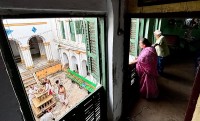NASA technology aims to save commercial airlines fuel, time
Washington, Sept 23 (IBNS) Two passenger airlines soon will test NASA-developed software designed to help air carriers save time and reduce fuel consumption and carbon emissions.
During the next three years, Virgin America and Alaska Airlines will use the Traffic Aware Planner (TAP) application, to make "traffic aware strategic aircrew requests" (TASAR).
"TAP connects directly to the aircraft avionics information hub on the aircraft," said David Wing, TASAR project lead at NASA’s Langley Research Center in Hampton, Virginia. "It reads the current position and altitude of the aircraft, its flight route, and other real-time information that defines the plane's current situation and active flight plan. Then it automatically looks for a variety of route and/or altitude changes that could save fuel or flight time and displays those solutions directly to the flight crew."
TAP also can connect with the plane's Automatic Dependent Surveillance-Broadcast (ADS-B) receiver and scan the ADS-B signals of nearby air traffic to avoid potential conflicts in any proposed flight path changes, making it easier for air traffic controllers to approve a pilot's route change request.
For airlines with Internet connectivity in the cockpit, TAP also can access information -- such as real-time weather conditions, wind forecast updates and restricted airspace status -- to further increase flight efficiency. The software is loaded onto a tablet computer, which many airline pilots already use for charts and flight calculations.
Wing and his team already have tested the TASAR software twice aboard a Piaggio P180 Avanti aircraft, a high-performance technology test bed owned and operated by Advanced Aerospace Solutions, LLC of Raleigh, North Carolina. The system worked well on its initial test flight from Virginia to Kentucky, according to its test pilot, former airline captain William Cotton.
"We used it to make a route change request from air traffic control, which they granted," said Cotton. "We got a shortcut that saved four minutes off the flight time."
Even four minutes of flight time shaved off of each leg of a trip made by an airline could result in massive fuel and time savings, according to researchers. The software provided similar results as flight tests continued in the northeast corridor. A second round of flight tests was recently completed to ensure readiness for operational use by partner airlines.
The TASAR flight tests came after a dozen pilots provided feedback on the technology in a simulation at the University of Iowa Operator Performance Laboratory in Iowa City, Iowa. In addition, aerospace systems manufacturer Rockwell Collins of Cedar Rapids, Iowa, analyzed TASAR to make sure it is safe and can be readily certified by the Federal Aviation Administration.
"We’re excited to partner with NASA to test this new technology that has the potential to help reduce fuel consumption and carbon emissions and save our guests time in the air.” said Virgin America Chief Operating Officer Steve Forte in Burlingame, California.
"Up until now there has been no way to deliver comprehensive wind and congestion data to pilots in near-real time," said Tom Kemp, Alaska Airlines’ vice president of operations in Seattle, Washington. "TASAR is a 'super app' that will give our pilots better visibility to what’s happening now versus three hours earlier when the flight plan was prepared."
Developers say the new technology won't require changes to the roles and responsibilities of pilots or air traffic controllers, which would allow the system to be implemented fast and start producing benefits right away.
"The system is meant to help pilots make better route requests that air traffic controllers can more often approve," said Wing. "This should help pilots and controllers work more effectively together and reduce workload on both sides from un-approvable requests. TASAR takes advantage of NASA's state-of-the-art TAP software, flight information directly from the aircraft and the emerging ADS-B and Internet infrastructure to help pilots get approved to fly the most efficient or time-saving trajectory possible."
NASA researchers expect this and other aviation technologies under development will help revolutionize the national airspace system, reducing delays and environmental impacts and improving passenger comfort and efficiency, even as the demand for air travel continues to grow.
(Image Credits: NASA/David C. Bowman)
Top Headlines
-
News
CSR in the Crossfire: Professor and practitioners debate over ethics in India Inc. at Kolkata's MCHD talk
October 24, 2025
-
News
Jashanpreet Singh Case: California under fire for licensing undocumented truck driver
October 24, 2025
-
News
India upgrades Technical Mission in Kabul to Embassy, days after Muttaqi's visit to New Delhi
October 22, 2025
-
News
Pakistan, Afghanistan agree to 48-hour ceasefire after deadly border clashes
October 15, 2025
-
News
Afghan Taliban, Pakistan exchange gunfire, dozens killed
October 15, 2025
-
News
Trump hails Netanyahu in Israel after hostage release, declares historic dawn of a new Middle East
October 13, 2025
-
News
Historic dawn of a new Middle East: Donald Trump addresses Israeli Parliament
October 13, 2025
-
News
Shah Rukh Khan receives maiden National Award from President Droupadi Murmu
September 23, 2025
-
News
Kolkata: Ahiritola Yubak Brinda invites Auram to make jewellery for Ma Durga and her family
September 20, 2025
-
News
Israel-US alliance 'never been stronger', Netanyahu says as State Secretary Rubio visit for talks
September 15, 2025





